Landscape Edging
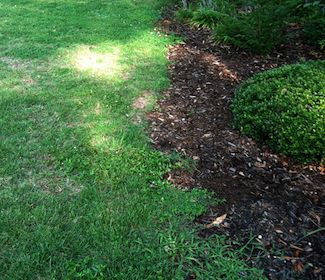
Landscape Edging - The Ragged Edge
Edging your landscape beds is one of the most important ways to improve the appearance of your lawn and flower beds. Placing a neat, well-kept border is like adding a coat and tie to your Sunday suit.
Commercial Landscape Edging Products:
There are many lawn and border edging products on the market today, including:
- Concrete Edging
- Steel Edging
- Plastic Edging
- Wood Edging
- Aluminum Edging
- Brick Edging
- Concrete Paver Edging
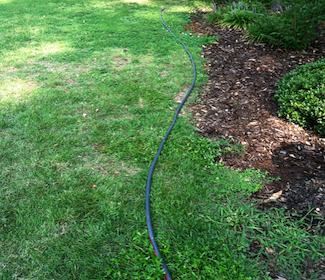
Landscape Edging - Layout Of Bed Line With Garden Hose
When installed correctly, each of these edging products makes for a wonderful looking, finished edge. These items can be quite costly, however,especially if you have a large landscaped area; they can also require a fair amount of maintenance to keep them looking their best over time.
One specific type of edging that is not listed above is the one that you may consider using, because of its simplicity and affordability. That type of edging is not available at your local garden center, as it is not for sale. What we are talking about here is a natural or organic lawn and border edge - in other words, one created simply from the landscape itself.
Natural Landscape Edging - Tools Required:
To produce a natural landscape edging, you need a few basic tools and supplies:
- Garden Hose - The reinforced type is best for curved edged areas and stiffer hoses work best.
- Wooden Stakes and Mason String for straight edged areas
- Tape Measure for straight edged areas
- Square edge garden spade
- Hand Cultivator
- Steel Rake
Natural Landscape Edging - How To Do It:
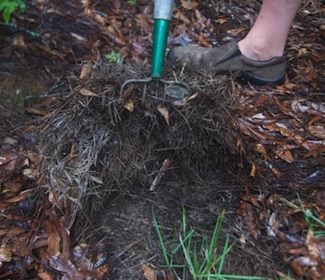
Landscape Edging - Pull Back The Mulch
Your first step is to cut your lawn to the proper height around the area you will be edging. If possible set your mower a notch or two lower around the area you will be edging. This will make sighting your edge much easier.
Straight Edged Areas:
The goal for these areas is to straighten out a ragged edge and make it razor sharp and straight. Usually you will need to pick a point in the lawn to edge so the entire edging will be bordered by the existing turf.
Start by measuring this point with the tape measure. Then pound two wooden stakes in the ground - one at each end of the area you are to edge.
Run the Mason Cord between the two stakes and pull it tight. That will act as your edge. The Mason strings should be entirely over existing turf area so when you are finished, the entire edge will be grass area.

Landscape Edging - Using A Garden Spade To Edge
Curved Edge Areas:
You should use a high quality, stiff hose for curves. It makes it easy to visualize the landscape edging and you can easily make adjustments to the edge with the hose. Begin by laying the hose on the ground and curve it around the areas you wish to edge. Make sweeping curves and no sharp corners, bends or kinks. If your hose is stiff enough, this will be a very easy task. Be sure to straighten out any kinks in the hose prior to laying it down. Make any final adjustments, making sure the curves are to your liking.
If you have mulch in your beds, now is the time to take the hand cultivator and pull the mulch back about 24" or so. This will make room for the excess material that will come out during the edging process.
Natural Edging - Pull Back the Mulch
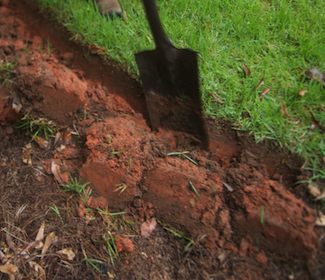
Landscape Edging - Clean-Up Edge And Make Flat
Next take the Garden Spade and rest it just inside the string or hose line that you laid out. About 1 inch inside the string or hose is just about right. The spade should be tilted back about 20 degrees (toward you), to make the cut. Cut down about 4 inches and pry the sod up to loosen it. Use this same process around the entire border.
Remove your line or the hose now that you've got the edging outline dug into the ground. Take the sod out in pieces and be sure to shake excess soil back into the excavation. Place all sod, weeds, and roots into a wheel barrow.
Now, cut down the bed area to make a flattened area about 12" wide from your cut edge, and continue this around the entire border.
Take your hand cultivator and replace the mulch (if there is any) back against the newly cut border edge. Add mulch if necessary. The mulch should have a final elevation about 1" below the turf edge.
Finally take the metal rake and cleanup the edging and excess material from the turf and just like that, you are finished!
Natural Landscape Edging - Without Mulch:
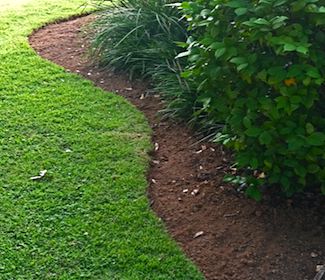
Landscape Edging - Finished Edge - Without Mulch
If you prefer to have just the edge without the mulch, simply follow the same procedure above; the only exception is that the flattened area next to the new edge can be much smaller. Fill the excavation with soil and leave the soil in the bed down about 1" from the turf elevation and gradually angle the bed up to the existing soil level.
Landscape Edging - Be Sure To Compost:
As a result of this process you will be accumulating a lot of material such as sod, weeds, twigs etc. Don't throw this stuff out! This material can easily be composted. Select an area in your yard and start a compost pile to recycle this material. If you need help with this, be sure to review our composting articles. Here are a few that will be of interest to you:
comments powered by Disqus


































































